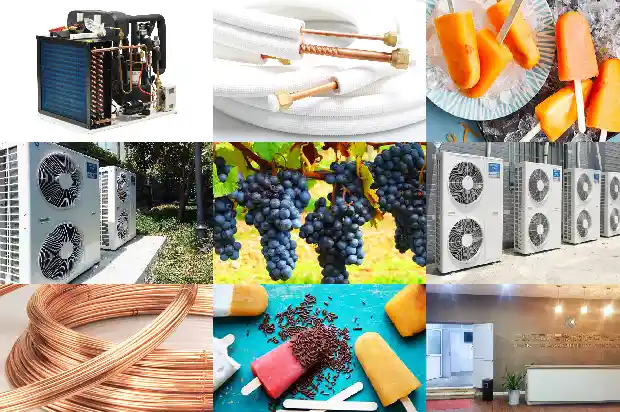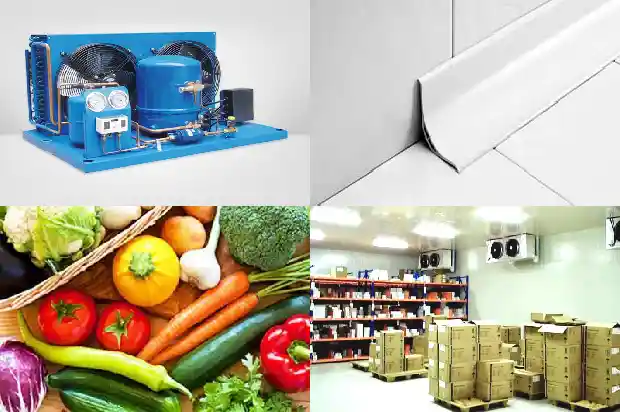What You Must Know About the Evaporation Temperature of the Refrigeration System!
2025-03-09
Hello, everyone.

- What is the Evaporation Temperature
The evaporation temperature is the critical temperature at which the refrigerant changes from a liquid to a gas. In a refrigeration system, it refers to the saturation temperature at which the refrigerant liquid changes from a liquid to a gas in the evaporator. Generally, the evaporation temperature in a refrigeration system cannot be measured directly and can only be deduced from the corresponding evaporation pressure. - The Relationship between the Evaporation Temperature and the Evaporation Pressure
The lower the evaporation pressure (low pressure), the lower the evaporation temperature; the higher the evaporation pressure (low pressure), the higher the evaporation temperature.
It can be said that the evaporation temperature and the evaporation pressure change proportionally. The evaporation pressure and the evaporation temperature correspond to each other.
Knowing the evaporation temperature, you can look up the value of the evaporation pressure in the table.
- Estimation of the Evaporation Temperature
When debugging refrigeration equipment, it is often necessary to know the evaporation temperature, further calculate the evaporation pressure, and then judge whether there is a problem with the refrigeration system according to the actual pressure.
The following is an empirical estimate: Evaporation temperature = Ambient temperature / Water temperature — (10~20℃).
Examples are as follows:
Example 1: In summer, the indoor temperature of the air conditioner is set at 26℃. Estimate the evaporation temperature at this time = 26 - (10~20℃) = 6℃. According to the temperature-pressure conversion table, the evaporation pressure at this time can be found to be about 0.55Mpa (for R22 refrigerant).
Example 2: For a cold storage at -18℃ with a storage room temperature of -18℃, the evaporation temperature of the refrigeration system at this time is approximately: Evaporation temperature = -18—(10~20) = -28℃. According to the temperature-pressure conversion table, the evaporation pressure at this time can be found to be about 0.21Mpa (for R404A refrigerant).
Note: When the ambient temperature is high, subtract the higher value (20℃); when the ambient temperature is low, subtract the lower value (10℃). - The Relationship between the Evaporation Temperature and the Power
It can be seen from the T - S diagram that if the evaporation temperature of the refrigeration system decreases, the consumed power increases.
The reason is that when the evaporation temperature decreases and the condensation temperature remains unchanged, the compression ratio of the compressor increases. The power of the compressor is directly proportional to the compression ratio, that is, as the compression ratio increases, the power of the compressor also increases.
It can be simply understood as: The power used by the compressor to compress 5 kilograms of refrigerant to 15 kilograms is definitely greater than the power used by the compressor to compress 1 kilogram of refrigerant to 15 kilograms. - The Relationship between the Evaporation Temperature and the Refrigeration Capacity
It can be seen from the relevant demonstrations that when the evaporation temperature decreases, the refrigeration capacity of the system also decreases.
The reason is that when the evaporation temperature decreases, the specific volume at the suction port decreases, resulting in a decrease in the refrigerant flow rate in the refrigeration system, that is, the refrigerant circulation amount decreases, and the refrigeration capacity of the refrigeration system also decreases. - The Relationship between the Heat Load and the Evaporation Pressure
Simply put, it is the relationship between the load on the evaporation side and the evaporation pressure.
Under constant working conditions (refrigerant flow rate), the greater the heat load, the higher the evaporation pressure, and vice versa.
The heat load of the evaporator is also related to the heat load air volume (wind speed). When the temperature at the air inlet of the evaporator box remains unchanged, the greater the air volume, the greater the heat load. - Analysis of the Reasons for Abnormal Evaporation Temperature during the Maintenance Process
7.1 The Evaporation Temperature is Low
There are many reasons for the low evaporation temperature. The mechanism leading to the low evaporation temperature is that there is less refrigerant in the evaporator or the heat exchange of the evaporator is not good. They are listed as follows:
7.1.1 The opening degree of the expansion valve is small.
7.1.2 The refrigeration system lacks refrigerant.
7.1.3 The capillary tube or the expansion valve is blocked.
7.1.4 The filter is blocked.
7.1.5 The air volume of the indoor unit is insufficient.
7.1.6 The evaporator is severely frosted.
Points 1 to 4 mainly analyze the situation of less refrigerant, and points 5 to 6 mainly analyze the poor heat exchange of the evaporator.
7.2 The Evaporation Temperature is High
The main reasons are listed as follows:
7.2.1 The opening degree of the expansion valve is too large.
7.2.2 There is too much refrigerant.
7.2.3 There is air in the system.
7.2.4 The outlet of the evaporator is blocked.
7.2.5 The condensation effect is not good.
7.2.6 The efficiency of the compressor is low or the rotation speed is low.
7.2.7 The valve plate of the compressor is broken or there is a leakage.
7.2.8 The heat load is too large.
Of course, there are many other reasons.
It is recommended to consider from three aspects:
7.2.9 There is too much refrigerant in the evaporator.
7.2.10 The condensing pressure is high.
7.2.11 The rotation speed of the compressor is low. - How to Control the Evaporation Temperature
Many manufacturers have heat exchanger test benches. In the heat exchanger test, the evaporation test is essential. The parameters controlled in the evaporation test are very simple, only four: the temperature before the valve, the pressure before the valve, the temperature at the outlet of the evaporator, and the pressure at the outlet of the evaporator. Because to qualitatively analyze the refrigeration capacity of an evaporator, as long as the temperature and pressure of the refrigerant at the inlet and outlet of the evaporator are controlled, a qualitative analysis can be carried out.
Here is a brief introduction on how to control the outlet pressure of the evaporator:
Controlling the outlet pressure of the evaporator is actually controlling the evaporation pressure of the evaporator. There are many methods. Here is the simplest one, which is to control it through an auxiliary expansion valve. The refrigerant in the liquid pipe bypasses and passes through the auxiliary throttle valve directly to the outlet of the evaporator. By adjusting the opening degree of this auxiliary throttle valve, the evaporation pressure can be controlled.
Related Articles
- Does a lower evaporation temperature result in a larger refrigeration capacity, or does a higher evaporation temperature lead to a larger refrigeration capacity?
- Why Does the Evaporation Temperature of the Refrigeration System Drop Too Low? And Why is the Condensing Pressure Too High?
- Principle of Multiple Storages in One Unit and Evaporation Pressure Regulation Methods
- Estimation of Temperature and Pressure in the Refrigeration System
- The Influence of Temperature Changes on the Air Conditioning Refrigeration System
- Cause Analysis of High Discharge Temperature and Overload Protection of Modular Units
- Understand Correctly the Dry-bulb Temperature, Dew-point Temperature and Wet-bulb Temperature
- What Misconceptions Should Be Avoided in Low - temperature Refrigeration System Repairs
- Introduction to the Advantages of Dual - temperature Cold Storage
- What are the characteristics of low-temperature cold storage?
- Requirements of Cold Storage Insulation for Maintaining Stable Temperature Inside
- Temperature Gradient Differences between Deep Foundation and Surface of Civil Cold Storage
- Temperature Requirements for Various Cold Storages
- Is the heating effect of air source heat pump air conditioner with enhanced vapor injection really good under low temperature conditions?
- 15 Reasons for Excessive Temperature Rise of Motors
- Types and Temperature Requirements of Seed Cold Storages
- Influence of Condensing Temperature Variation on Vapor Compression Refrigeration System
- Introduction to the Relationship between Refrigerants and Cold Storage Temperatures
